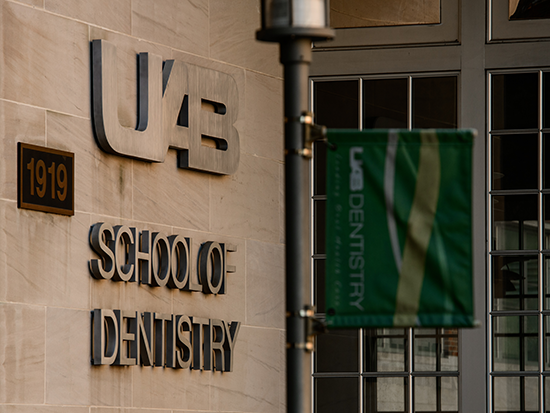This study analyzed the oral health of geriatric and pediatric patients in Southeast Alaska.
Media contacts:
Anna Jones
Kathryn Sawyer
 This study analyzed the oral health of geriatric and pediatric patients in Southeast Alaska.American Indians and Alaska Natives experience the highest population burden of oral health problems. That’s why researchers at the University of Alabama at Birmingham School of Dentistry are partnering with the Southeast Alaska Regional Health Consortium to help better understand and improve oral health among the region’s geriatric and pediatric populations.
This study analyzed the oral health of geriatric and pediatric patients in Southeast Alaska.American Indians and Alaska Natives experience the highest population burden of oral health problems. That’s why researchers at the University of Alabama at Birmingham School of Dentistry are partnering with the Southeast Alaska Regional Health Consortium to help better understand and improve oral health among the region’s geriatric and pediatric populations.
Geriatric Oral Health in Southeast Alaska
Joanna Cunha-Cruz, DDS, Ph.D., professor at UAB, received a R01 million grant from the National Institutes of Health to improve the oral health of vulnerable patient groups in Southeast Alaska. With this grant, Cunha-Cruz is partnering with SEARHC to gain important knowledge about how to improve clinical decision-making for better oral health among the geriatric Alaska Native population.
Older Alaska Native adults have nearly three times the rate of untreated tooth decay compared to white adults in the United States ¾ 46 percent versus 16 percent, respectively ¾ and over 10 percent more than black adults in the United States, according to the Indian Health Service. They are more likely to have periodontal disease than other racial and ethnic groups. This burden is believed to be due to the social determinants of health that this population faces, including access to care and financial burdens.
“Periodontal disease is associated with several other systemic diseases affecting the lungs, heart, brain and kidneys,” said Marcia Wayland, DDS, a dentist at Mt.Edgecumbe Medical Center – Dental Clinic. “The elderly population can be affected in several ways: decreased salivation due to multiple medications, lack of dexterity and visual impairment. Looking at the patient holistically will lead us to adjust and provide the best treatment.”
The researchers are working with SEARHC Dental Clinics to invite patients 60 years of age or older to participate in the study. SEARHC is one of the largest Native-run tribal health organizations in the country, providing dental, physical and behavioral health services to all Southeast Alaskans. The organization serves patients in two hospitals and multiple clinics throughout the region, covering 27 communities. This partnership allows researchers to see the outcomes of care, treatment opportunities and challenges for patients in Southeast Alaska communities and how oral disease progresses in this population.
“This study is innovative and highly relevant to public health and clinical research as it addresses the lack of rigorous prospective studies and the uncertainty in prognosis and prognostic factors in the management of oral disorders in patients suffering the highest burden of oral disease,” said Cunha-Cruz. “We will gain important knowledge about how to potentially improve clinical decision-making for improved geriatric oral health in Alaska Natives.”
Researchers and providers are exploring how a team approach, including dentists working with dentists, dentists, dental assistants and community health aides, can benefit the patient. They analyze the relationships between certain medical conditions and the progression of periodontal disease, helping to identify barriers to accessing care and focusing on improving care delivery systems.
“By implementing collaboration between the patient’s dental and medical providers, we are able to treat the whole patient,” said Mandy Smith, DDS, senior clinical advisor in the SEARHC Dental Program. “We want to provide care that looks at the whole person, not just their oral health needs. Our overall goal of this research is to use a holistic approach to health care for prevention and behavior change to improve the quality of life and longevity of our seniors.
Pediatric Oral Health in Southeast Alaska
In addition to studying oral health among geriatric populations, Cunha-Cruz partnered with SEARHC on a published study that analyzed pediatric oral health in the region. American Indian and Alaska Native children suffer from the worst oral health of any population group in the United States. And while evidence-based practices for controlling caries, more commonly called cavities, are well established, implementing those practices is difficult.
With this study, Cunha-Cruz and her team focused on working with providers to develop interventions and goals for children’s oral health. After clinics established their goals, researchers worked with these providers to develop clinical guidelines and identify the most common barriers to guideline implementation. Providers then created action plans to overcome these barriers. Over the course of the study, the researchers rechecked these clinics to make sure they were on track to meet their goals.
“This research allowed dental providers to consider the steps they are taking in these clinics to help these pediatric populations and determine if there are any changes that need to be made to better address health disparities in the Southeast Alaska region,” Cunha-Cruz said.
Qualitative research can inform the design and evaluation of process-oriented implementation strategies for many clinical guidelines with the potential to reduce health disparities and improve health outcomes in American Indian and Alaska Native children and adolescents.
